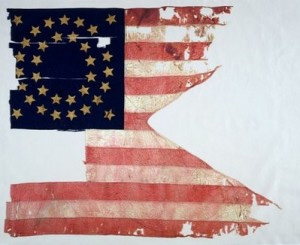
|  |  |  Americas & Beyond Americas & Beyond  
Anyone Want to Buy Custer’s Monument to Military Stupidity?
 Matthew Brown - Associated Press Matthew Brown - Associated Press
go to original
December 10, 2010


| | This photo provided by Sotheby's in New York shows The Culbertson Guidon from the 1876 Battle of the Little Bighorn. On Friday, Dec. 10. 2010, the swallow-tailed 7th U.S. Cavalry flag, known as a "guidon," is expected to bring up to $5 million at an auction at Sotheby's in New York. (AP/Sotheby's, File) |  |
Frayed, torn and maybe even a little bloodstained, the only U.S. flag not captured or lost during George Armstrong Custer‘s “Last Stand” at the Battle of Little Bighorn sold for $54 when it first surfaced in the 1890s.

On Friday, the swallow-tailed 7th U.S. Cavalry flag, known as a “guidon,” is expected to bring up to $5 million at an auction at Sotheby‘s in New York.

And while Custer’s reputation has risen and fallen over the years — once considered a hero, he’s regarded by some contemporary scholars as an inept leader and savage American Indian killer — the guidon has emerged as the stuff of legend.

“It’s more than just a museum object or textile. It’s a piece of Americana,” said John Doerner, Chief Historian at the Little Bighorn Battlefield National Monument in southeastern Montana. “I hope it ends up with a collector that can share that with the American public.”

During the June 25, 1876, battle, Custer and more than 200 of his men were cut down by a force of up to 1,800 Lakota Sioux and Cheyenne warriors, on what later became the Crow Indian Reservation.

Of the five guidons carried by Custer’s troopers, only one was immediately recovered. It was found pinned beneath the body of Cpl. John Foley by a burial party that arrived three days after the battle was over.

The other flags were believed captured by the victorious Indians.

The recovered flag later became known as the Culbertson Guidon, after the member of the burial party who recovered it, Sgt. Ferdinand Culbertson. Made of silk, the flag measures 33 inches by 27 inches, and features 34 gold stars.

Since 1895, it has been the property of the Detroit Institute of Arts, formerly known as the Detroit Museum of Art.

For most of that time the flag was hidden from public view, kept in storage first at the museum and later in a National Park Service facility in Harper’s Ferry, Md., according to Institute of Art director Graham Beal.

Dating to an era when the museum took in a variety of natural history and historical items, the guidon is being sold because it does not fit with the museum’s focus on art, Beal said.

“The irony is you get all these people phoning the museum upset we’re selling the flag, and no one knew we owned it,” he said. “We had people threatening to come down and see the flag — never mind that it was on its way to New York.”

A second 7th Cavalry guidon was recovered in September 1876, at the Battle of Slim Buttes near present-day Reva, S.D.

Now in possession of the Little Bighorn Battlefield National Monument, that flag was poorly cared for and is now in horrible condition — “almost dust,” according to the monument’s chief of interpretation, Ken Woody.

As for Culbertson’s Guidon — or Custer’s Last Flag, as Sotheby’s has billed it — Woody pointed out that without the Custer mystique, it would be just another piece of old cloth.

“Some people like memorabilia and Americana, and they all want to own a little piece of it,” Woody said.

Sealed in a custom-made plexiglass case by the Detroit museum since its return from the Park Service in 1982, the flag has several holes in it and the red of some its stripes has run into the white stripes. The once-sharp swallow tail tips are now tattered and torn.

Culbertson’s Guidon also is missing a star and a section of striping about 9 inches wide and 6 inches high — apparently cut away as a souvenir before its acquisition by the museum. Yet on the auction block, even what’s missing gets a story.

“I’m sure Culbertson let other men take small snippets for themselves,” Sotheby’s vice chairman David Redden said.
|

 |
|  |



